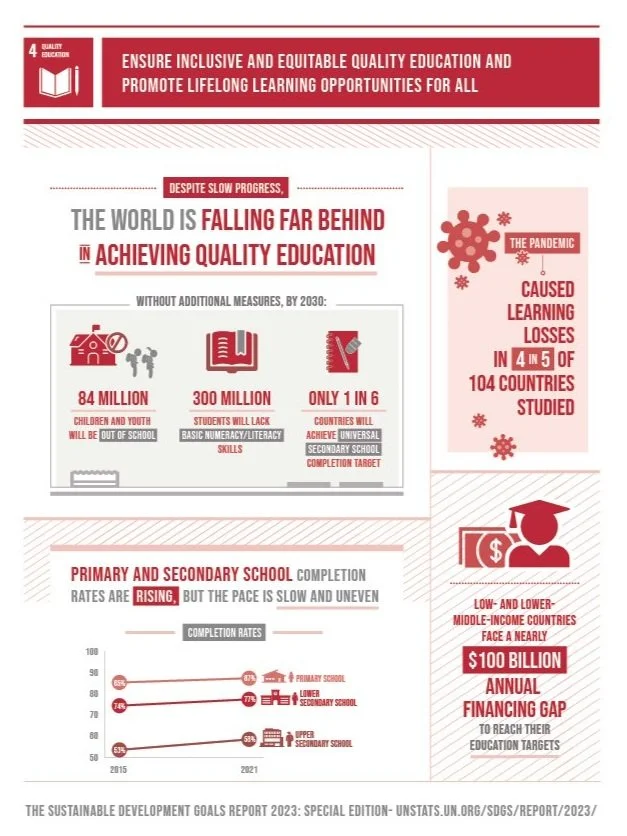Quality Education SDG 4
Education is a cornerstone of sustainable development and a powerful tool to break the cycle of poverty. Sustainable Development Goal 4 (SDG 4) aims to “Ensure inclusive and equitable quality education and promote lifelong learning opportunities for all.” This ambitious goal comprises 10 targets and 11 indicators, addressing children’s and adults’ education (Targets 4.1, 4.2, 4.3), skills development (Targets 4.4, 4.6, 4.7), gender disparity (Target 4.5), and critical enablers like facilities and teacher quality (Targets 4.a, 4.b, 4.c).
NAV, a non-profit dedicated to empowering at-risk youth in foreign countries, integrates SDG 4 into its mission by focusing on nurturing foundational education, providing essential resources, and fostering lifelong learning opportunities. This page explores how NAV aligns with SDG 4 and its critical role in transforming education systems in underserved communities.
Understanding SDG 4 and Its Relevance to NAV’s Mission
SDG 4 emphasizes universal access to quality education and equitable learning opportunities. Education is not only a right but also a powerful lever to address inequalities and promote economic growth. NAV’s pillars—Nurture, Aid, and Vision—are intrinsically tied to the principles of SDG 4, ensuring that every child has the tools to thrive academically and personally.
How NAV Tackles SDG 4 Targets
1. Nurture: Building a Strong Educational Foundation
NAV’s Nurture initiatives focus on creating environments where at-risk youth can access and excel in education. This directly supports Targets 4.1 and 4.2.
Primary and Secondary Education (Target 4.1): NAV ensures that children have access to quality education by delivering essential school supplies to under-resourced classrooms.
Early Childhood Development (Target 4.2): By providing resources for early childhood education, NAV ensures that children from vulnerable communities start their educational journey with a solid foundation, fostering their cognitive, social, and emotional development.
2. Aid: Addressing Barriers to Education
NAV’s Aid pillar tackles systemic barriers that prevent equitable access to education. This aligns with Targets 4.5, 4.a, and 4.b.
Eliminating Gender Disparities (Target 4.5): NAV prioritizes educational opportunities for girls, who often face disproportionate barriers to schooling in underserved regions.
Improving Educational Facilities (Target 4.a): NAV invests in safe and inclusive learning environments, equipping schools with essential infrastructure like desks, books, chalk, and pencils.
3. Vision: Promoting Lifelong Learning and Skill Development
Vision emphasizes equipping youth with skills for long-term success, aligning with Targets 4.3, and 4.6.
Access to Technical and Vocational Training (Target 4.3): NAV facilitates technical and vocational education programs, preparing youth for meaningful employment opportunities by providing schools with the supplies they need.
Literacy and Numeracy (Target 4.6): NAV supplies schools with books for students to learn reading and numeracy.
To evaluate its contributions to SDG 4, NAV aligns its programs with measurable outcomes:
Enrollment Rates: Tracking increases in primary, secondary, and vocational school enrollment.
Gender Parity Index: Monitoring the ratio of girls to boys in educational programs.
Infrastructure Improvements: Measuring the number of schools equipped with improved facilities.
Literacy Levels: Assessing progress in literacy and numeracy among youth and adults.
Employment Outcomes: Evaluating job placements and economic mobility of program beneficiaries.
Challenges and Opportunities
Challenges
Funding Limitations: Expanding educational initiatives often requires significant financial investment.
Cultural Barriers: Addressing gender disparities and societal norms requires ongoing community engagement.
Opportunities
Technology Integration: Using digital tools to expand access to education and deliver remote learning opportunities.
Public-Private Partnerships: Collaborating with corporations and governments to scale initiatives.
Advocacy and Awareness: Raising awareness about the importance of education through global campaigns.
Conclusion
NAV’s comprehensive approach to education exemplifies how non-profits can meaningfully contribute to SDG 4. By nurturing young minds, removing barriers to education, and promoting lifelong learning, NAV not only empowers individuals but also strengthens communities and fosters sustainable development. Education is the foundation for a brighter future, and through its targeted efforts, NAV is ensuring that no child is left behind. Together, we can build a world where every child has the opportunity to learn, grow, and thrive.
